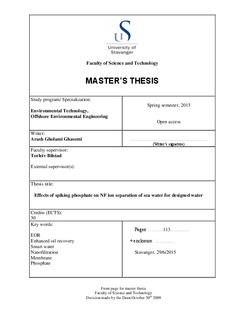| dc.contributor.author | Gholami Ghasemi, Arash | |
| dc.date.accessioned | 2015-09-17T07:43:19Z | |
| dc.date.available | 2015-09-17T07:43:19Z | |
| dc.date.issued | 2015-06 | |
| dc.identifier.uri | http://hdl.handle.net/11250/300368 | |
| dc.description | Master's thesis in Environmental technology | nb_NO |
| dc.description.abstract | The thesis investigates the Effects of spiking phosphate on nanofiltration (NF) membrane ion separation for production of phosphate-containing designed water. Enhanced oil recovery in carbonate reservoir by seawater injection calls for modification of seawater ionic composition. Low concentration of monovalent ions (sodium and chloride) together with high concentration of divalent ions (sulfate, calcium and magnesium) are characteristics of this modified seawater known as designed water. Recent research findings show that increase in recovery is achievable when designed water contains phosphate. Ability of nanofiltration (NF) membrane to retain multivalent ions and permeate monovalent ions makes this separation process a suitable technique for production of designed water.
Effects of pressure, feed concentration and pH was experimented when phosphate chemicals were introduced into seawater as NANO-SW-2540 membrane feed. The membrane showed to reject ions in sequence of R(sulfate) > R(phosphate) > R(magnesium) > R(calcium) > R(chloride) > R(sodium). Increase in operational pressure led to a rise in permeate flux and rejection rates. Desirable recovery reduction was obtained by adding phosphate salts and increasing its concentration in membrane feed. Moreover, a downward trend was also observed in retention of normal seawater ions as a result of increasing concentration of phosphate salt in membrane feed resulted from screening phenomenon. Between the two phosphate salts, second one showed to contribute to higher phosphate rejection of 94 to 98% as well as higher monovalent permeation when its third dose was introduced into feed solution. Increasing pH of feed solution led to both higher recovery and ion permeation. Phosphate rejection ranged between 85 to 98% rejection at solution pH of 8 and decreased by about 40% when pH of feed was inclined to 11. | nb_NO |
| dc.language.iso | eng | nb_NO |
| dc.publisher | University of Stavanger, Norway | nb_NO |
| dc.relation.ispartofseries | Masteroppgave/UIS-TN-IMN/2015; | |
| dc.subject | teknisk miljøvern | nb_NO |
| dc.subject | offshore teknologi | nb_NO |
| dc.subject | EOR | nb_NO |
| dc.subject | enhanced oil recovery | nb_NO |
| dc.subject | smart water | nb_NO |
| dc.subject | nanofiltration | nb_NO |
| dc.subject | membrane | nb_NO |
| dc.subject | phosphate | nb_NO |
| dc.title | Effects of spiking phosphate on NF ion separation of sea water for designed water | nb_NO |
| dc.type | Master thesis | nb_NO |
| dc.subject.nsi | VDP::Technology: 500::Environmental engineering: 610 | nb_NO |
